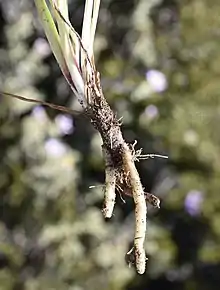Microseris lanceolata
Microseris lanceolata is an Australian alpine herb with yellow flowers and one of three plants known as murnong or yam daisy along with Microseris scapigera and Microseris walteri.[2]
| Microseris lanceolata | |
|---|---|
 | |
| Scientific classification | |
| Kingdom: | |
| (unranked): | |
| (unranked): | |
| (unranked): | |
| Order: | |
| Family: | |
| Subfamily: | |
| Tribe: | |
| Genus: | |
| Species: | M. lanceolata |
| Binomial name | |
| Microseris lanceolata | |
| Synonyms[1] | |
| |
The plant is found in southern parts of Australia, including Victoria, NSW and ACT.[3] In Victoria, the plant is confined to alpine and subalpine herbfields of the eastern ranges, and often locally plentiful. Microseris walteri and Microseris scapigera are found in a greater number of locations than Microseris lanceolata. [4]
Botanical naming
For more than 30 years Murnong was named as Microseris sp. or Microseris lanceolata or Microseris scapigera. Royal Botanic Gardens Victoria botanist Neville Walsh clarified the botanical name of Microseris walteri in 2016 and defined the differences in the three species in the table below.[4]
| Feature | M. walteri | M. lanceolata | M. scapigera |
|---|---|---|---|
| Roots | single fleshy root expanding to a solitary, napiform to narrow-ellipsoid or narrow-ovoid, annually replaced tuber | several fleshy roots, cylindrical to long-tapered, branching just below ground-level | several cylindrical or long-tapered, usually branched shortly below leaves |
| Fruit (Capsela) | usually less than 7mm long | usually less than 7mm long | mostly 7–10 mm long |
| Pappus bristles | c. 10 mm long, 0.5–1.3mm wide at base | 10–20 mm long, c. 0.3–0.5 mm wide at base | 30–66 mm long |
| Joined petals (Ligule) | usually more than 15mm long | usually more than 15mm long | up to 12mm long |
| Origin | lowlands of temperate southern WA, SA, NSW, ACT, Victoria and Tasmania | rarely on basalt soils; alpine and subalpine NSW, ACT and Victoria | mostly from basalt plains of western Victoria and elevated sites in Tasmania |
| Taste of roots | sweet-tasting, both raw and cooked | bitter, slightly fibrous and not particularly palatable | slightly fibrous, and slightly, but tolerably bitter |
Biological descriptions
Microseris lanceolata has the form of a tufted rosette of toothed lanceolate leaves. [5]
The flower is a yellow head of florets, similar to flatweed (Hypochaeris radicata) or dandelion (Taraxacum). In its natural alpine and subalpine environment, the flower begins to blossom in December when the temperature reaches about 20C. The flower stalk is pendulous before flowering, becoming erect for flowering to attract pollinators and again with the ripening of the seed head. The seed heads ripen to a cluster of fluffy, tan achenes, each having a crown of fine extensions called a pappus. The seeds are dispersed by wind. [6]
The plant has several fleshy roots branching just below ground level, rather than a tuber like Microseris walteri. [4]
Cultivation and uses
The edible tuberous roots of murnong plants were an important source of food for some Aboriginal Australian peoples. However, the descriptions of murnong are more closely aligned with Microseris walteri. To add to the confusion, commercial nurseries will commonly mislabel a Microseris scapigera plant as Microseris lanceolata.
Gallery
 Microseris lanceolata flower, approximately 5cm wide
Microseris lanceolata flower, approximately 5cm wide Microseris lanceolata roots, branching just below ground-level
Microseris lanceolata roots, branching just below ground-level Murnong seed clock
Murnong seed clock Seed comparison, from left to right: Microseris scapigera, Microseris walteri and Microseris lanceolata
Seed comparison, from left to right: Microseris scapigera, Microseris walteri and Microseris lanceolata
References
- The Plant List: A Working List of All Plant Species, retrieved 1 July 2016
- Gott, Beth (1993). "Use of Victorian plants by Koories". In Foreman, Don B.; Walsh, Neville G. (eds.). Flora of Victoria. 1. Melbourne: Inkata Press. pp. 195–211. ISBN 978-0-909605-76-6.
- "Microseris lanceolata (Walp.) Sch.Bip". Australian Plant Name Index (APNI), IBIS database. Centre for Plant Biodiversity Research, Australian Government. Retrieved 4 Mar 2013.
- Walsh, Neville (2016). "A name for Murnong (Microseris: Asteraceae: Cichorioideae)" (PDF). Muelleria. 34.
- Cribb, A.B.; Cribb, J.W. (1974). Wild Food in Australia. Sydney: William Collins. pp. 150–151. Retrieved 14 August 2019.
- Gott, Beth (1983). "Murnong - Microseris scapigera: A study of a staple food of Victorian Aborigines". Australian Aboriginal Studies. 2: 2–17.